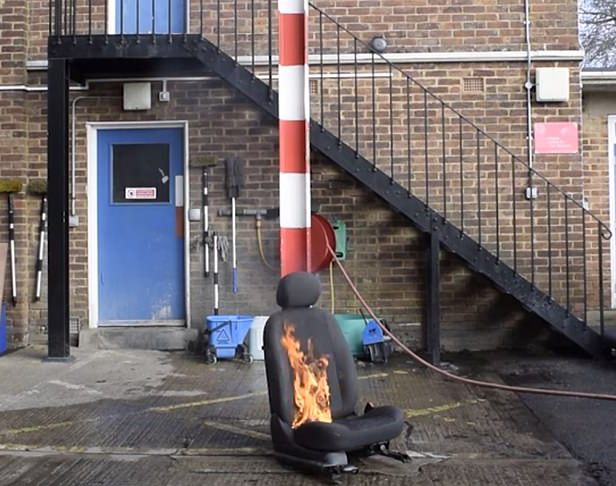
In tests, a full lit pack sets a car seat on fire within 200 seconds.
Fire investigators learned about the potential for crisps to be used to start fires after talking to colleagues in the prison service, who were familiar with the technique.
They turned to university experts for help and testing was carried out using car seats to see how quickly a lit bag of crisps would set them on fire. Findings confirm the theory that crisps are excellent accelerants. Car seats were used so the tests could take place outside. The results would be the same if home furnishings, such as a sofa, were tested.
"When forensics teams go to investigate arson they're looking for an accelerant, such as petrol," says Linda Brownlow, the university's forensics lead.
"Also, someone looking to start a fire who is carrying a can of petrol stands out. No one's going to look twice at someone with a bag of crisps, and the evidence destroys itself. This is especially helpful if someone is trying to make a deliberate fire look accidental. Criminals have presumably worked this out and told each other.
"Crisps encourage fire - they feed it - because they are hugely calorific and fatty. As the video shows, a packet of crisps - either the potato ones or the puffy, maize or corn-based ones - can set a car seat on fire within 200 seconds. Plenty of time for someone to get away."
Student Emily Duffin worked on the research for her final-year Forensic Science with Criminology degree project, for which she gained a first.
Emily carried out small tests on 10 types of crisp, checking how long they took to set alight, how long they burned for and how long they continued to hold their heat after the initial flames had died down. Each type was tested three times. Factors such as ingredients, shape, packaging and calorific value were all taken into consideration.
For larger-scale testing Linda and Emily used facilities at Kent Fire and Rescue Service Headquarters in Maidstone, Kent. In these tests three packs of crisps were tested.
Emily adds: "In terms of calories, there was little difference in everything tested. They all lit and burned quickly and strongly enough to set the seat on fire. The firefighters at the test expected the crisps to go out before they had a chance to set the seat on fire - they were amazed."
The next step is looking at whether a lit bag of crisps thrown through a letterbox will stay alight long enough to start a fire, Linda says. "Because that sort of malicious damage is more common with 'amateur' arsonists, rather than covering up a crime.
"I'm not convinced a thrown pack would stay lit for long enough but this is why we test things, you never know. We'll need to build a rig, a kind of mock hallway, with a door and letterbox and various floor types so we can compare burn patterns on the back of the door."
Emily has presented her findings at ICFSST 2019: the International Conference on Fire Safety Science and Technology, held in London.
Findings:
In all of the large-scale experiments (where the full packets were lit and placed on a car seat) the fire was significant and sustained within 200 seconds.
Different types of crisps burned in different ways, but this proved not be of statistical significance.
The mean average time individual crisps burned for was 75.92 seconds.
The mean average time for the for fire to spread from the full packets of crisps to the car seat was 100 seconds.

